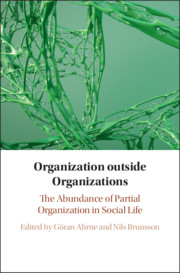Book contents
- Organization outside Organizations
- Organization outside Organizations
- Copyright page
- Contents
- Preface
- Contributors
- Introduction
- Part 1 Rules, Sanctions, Membership
- Part 2 Organization in and around Markets
- Part 3 Networks and Other Social Relationships
- 9 The Inter-Firm Network as Partial Organization?
- 10 An Organized Network: World Economic Forum and the Partial Organizing of Global Agendas
- 11 Organizing Intimacy
- 12 How Is ‘Organized Crime’ Organized?
- 13 Brotherhood as an Organized Social Relationship
- Part 4 Social Movements and Collective Action
- Part 5 The Partial Organization of Formal Organizations
- Conclusion
- Index
- References
11 - Organizing Intimacy
from Part 3 - Networks and Other Social Relationships
Published online by Cambridge University Press: 11 July 2019
- Organization outside Organizations
- Organization outside Organizations
- Copyright page
- Contents
- Preface
- Contributors
- Introduction
- Part 1 Rules, Sanctions, Membership
- Part 2 Organization in and around Markets
- Part 3 Networks and Other Social Relationships
- 9 The Inter-Firm Network as Partial Organization?
- 10 An Organized Network: World Economic Forum and the Partial Organizing of Global Agendas
- 11 Organizing Intimacy
- 12 How Is ‘Organized Crime’ Organized?
- 13 Brotherhood as an Organized Social Relationship
- Part 4 Social Movements and Collective Action
- Part 5 The Partial Organization of Formal Organizations
- Conclusion
- Index
- References
Summary
Despite strong emotions and a high density of communication, intimacy does not preclude organization. Intimate relationships can often be recognized as partially organized. In this chapter I examine three intimate relationships – families, kinship, and friendship – in order to investigate how the variation in combinations of organizational elements can be explained by the core component of love in each type of relationship.In examining the appearance of organizational elements in intimate relationships, one can see considerable differences among them, not only in their degree of organization, but also in the elements that are present. There is a connection between the elements that appear in a relationship and the emotional content. But there are also differences within the same type of relationship in how much and in which ways they are organized. An investigation of organizational elements in intimate relationships also provides an awareness of the limits of organization and why intimate relationships remain partially organized.A broadening of the analysis examining connections between states and intimate relationships demonstrates why states can use membership as an organizational element only to a limited extent. States are extremely organized in many respects, yet they are only partially organized.
- Type
- Chapter
- Information
- Organization outside OrganizationsThe Abundance of Partial Organization in Social Life, pp. 235 - 252Publisher: Cambridge University PressPrint publication year: 2019



